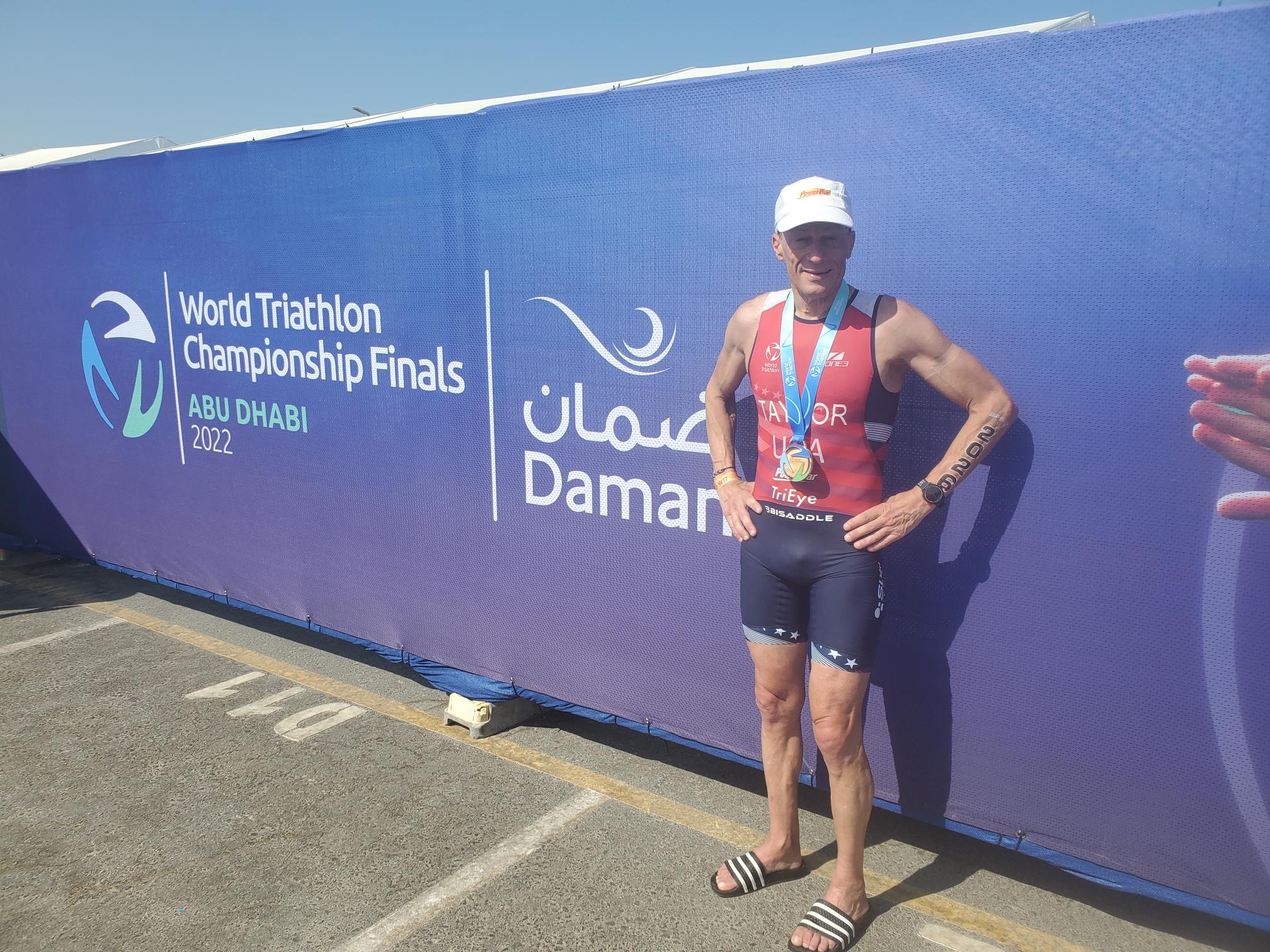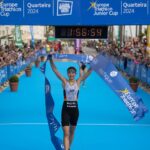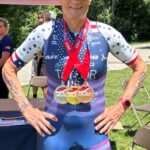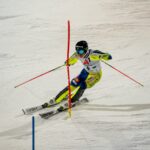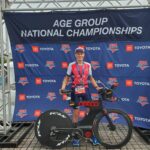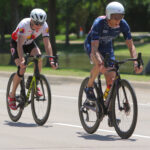If you would have told me 14 months ago that I would compete in the 2022 World Triathlon Championships in Abu Dhabi and come away with a bronze medal in the Super-sprint and a 9th place in the Olympic distance in my age group, I would have certainly told you that you were crazy.
Championships in Abu Dhabi and come away with a bronze medal in the Super-sprint and a 9th place in the Olympic distance in my age group, I would have certainly told you that you were crazy.
I remember sitting in the middle of Pacific Coast Highway, just north of Malibu. I had just been hit by a car—a hit-and-run—and I was totally lucid (learn more about the incident and the immediate aftermath). My first thought was “My bike is destroyed.” My second thought was “I think I’m okay.” My third thought was “I’m not going to be able to race in the Malibu Triathlon the next two days.” Sitting where I sit now, healthy and pain-free, reflecting back to that moment, my fourth thought was not going to be “I’m going to have a triathlon season that exceeds all of my hopes, dreams, and expectations.” More like, “I’m lucky to be alive.” If the car had hit me 12 inches toward the front of my bike, I would probably be dead…or worse.
 This article isn’t intended to be some sort of tribute to my fortitude and resilience. To be honest, since writing that initial article about my hit-and-run I’ve heard from many triathletes and cyclists who sustained far more serious injuries and whose return to health and our sport was much more difficult. Rather, my goal is to provide some context for the journey I’ve been on and, more importantly, to set the stage for a discussion about what enabled me to get from the UCLA Level I Trauma Center on that fateful day to today, healthy, mostly fit, and competing at the highest level of age-group triathlon.
This article isn’t intended to be some sort of tribute to my fortitude and resilience. To be honest, since writing that initial article about my hit-and-run I’ve heard from many triathletes and cyclists who sustained far more serious injuries and whose return to health and our sport was much more difficult. Rather, my goal is to provide some context for the journey I’ve been on and, more importantly, to set the stage for a discussion about what enabled me to get from the UCLA Level I Trauma Center on that fateful day to today, healthy, mostly fit, and competing at the highest level of age-group triathlon.
Of course, I would never have chosen to have taken this journey, yet life sometimes sends us off course and it’s our responsibility to do everything we can to get back on course (an apt metaphor for triathlon, wouldn’t you agree?). From this almost-year-long experience, I have certainly learned some valuable lessons that I hope other athletes who are struggling to recover from injuries might benefit from to help them get back on the road to health, fitness, training, and racing.
and it’s our responsibility to do everything we can to get back on course (an apt metaphor for triathlon, wouldn’t you agree?). From this almost-year-long experience, I have certainly learned some valuable lessons that I hope other athletes who are struggling to recover from injuries might benefit from to help them get back on the road to health, fitness, training, and racing.
I come to these lessons wearing both my professional and triathlete hats. As a Ph.D. in Psychology who specializes in sport psychology, I have written two books on the psychology in injury and have worked with injured athletes for decades. As a lifelong athlete (alpine ski racer, martial artist, marathon runner) and now a committed triathlete, I have been fortunate to have mostly avoided serious injury until last September 24th. But the last 14 months have been a real education for the triathlete side of me and first-hand experience for what my injured clients go through for the “shrink” side of me.
 With all that said, here are the seven essential lessons I have learned that took me from serious injury to a level in triathlon that I never expected to reach, with or without my injuries.
With all that said, here are the seven essential lessons I have learned that took me from serious injury to a level in triathlon that I never expected to reach, with or without my injuries.
Have Hope
My return from those injuries started with an emotion—hope. Hope (or its absence) is the foundation of everything that happens after a traumatic event. In sum, hope is the deep feeling that good things will happen again. Hope is the fuel that keeps us positive and propels us toward healing, recovery, and return to sport. In those first few weeks of being on crutches, despite the pain and upheaval in my life, I felt that hope from the diagnosis and prognosis I was given, and the support I received from family, friends, and the triathlon community. That hope buoyed me through the initial stage of my recovery when I was in a lot of pain, still wrapping my arms around the challenges that lay ahead, and whenever I began to sink low.
Yet, after a serious injury takes us away from the activities and people we love, and creates uncertainty, doubt, and worry, it’s often difficult to find hope in what initially appears to be a decidedly hopeless situation. It requires optimism, a steely determination, and often “borrowing” that hope from the people who care most about you.
doubt, and worry, it’s often difficult to find hope in what initially appears to be a decidedly hopeless situation. It requires optimism, a steely determination, and often “borrowing” that hope from the people who care most about you.
Trust Your Sports Medicine Team (SMT)
Because few of us are experts in the rehabilitation of physical injuries, we don’t know enough to judge whether we can return to health, how long it will take, and what the process of healing and rehabilitation involves. As a result, we must rely on our SMT to guide us. Yet, putting our faith in our SMT requires trust that they understand our injuries and know the best path to health.
 I quickly lost that trust in my original SMT when my orthopedist told me that, after six weeks on crutches, I would need to be non-weight-bearing for another six weeks. I decided to seek a second opinion with my long-time friend and book co-author, Dr. Kevin Stone, one of the world’s leading sports orthopedists in the world (I didn’t go to him originally because my insurance didn’t cover him and my injuries seemed pretty clear cut). The first thing he said after examining me was, “Let’s get you back walking” and, three days later, I was walking without crutches and riding my indoor bike.
I quickly lost that trust in my original SMT when my orthopedist told me that, after six weeks on crutches, I would need to be non-weight-bearing for another six weeks. I decided to seek a second opinion with my long-time friend and book co-author, Dr. Kevin Stone, one of the world’s leading sports orthopedists in the world (I didn’t go to him originally because my insurance didn’t cover him and my injuries seemed pretty clear cut). The first thing he said after examining me was, “Let’s get you back walking” and, three days later, I was walking without crutches and riding my indoor bike.
From that moment forward, I trusted Dr. Stone and his rehab team to shepherd me through the healing of my injuries and my return to triathlon. And, as I noted above, that trust has paid off brilliantly.
Stick with the Plan
Like many triathletes, I was at risk of sabotaging myself with the “more is better” mentality. Gosh, if three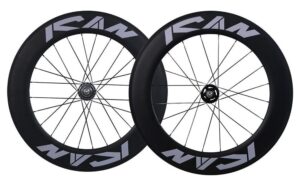 sets of exercises is good in my rehab, wouldn’t five sets be better? Well, actually no. Perhaps the single most important lesson I learned from my ordeal was simply to “stick with the plan,” meaning do exactly what your SMT tells you to do, no more, no less. For motivated athletes, the “no less” part is pretty easy, but it’s really difficult to not get sucked into the “no more” part.
sets of exercises is good in my rehab, wouldn’t five sets be better? Well, actually no. Perhaps the single most important lesson I learned from my ordeal was simply to “stick with the plan,” meaning do exactly what your SMT tells you to do, no more, no less. For motivated athletes, the “no less” part is pretty easy, but it’s really difficult to not get sucked into the “no more” part.
From September 25th (the day after the collision), I had a number imprinted in my brain: seven months. That was how much time I had before my first big races of 2022, the USAT Multisport National Championships. By the turn of the new year, that seven months had shrunk considerably, and I was nowhere near ready to race. I was actually quite a good patient who did what I was told until I was feeling pretty good physically (no limp, little pain, most of my right-leg strength back) after about ten weeks. After that, I felt constantly compelled to do a little more a little sooner. At that point, I made the poor decision of not sticking with the plan. I tried running for the first time in mid-December by doing laps in my very small backyard on our artificial grass. Bad idea! It hurt like hell. In an MRI in shortly after, Dr. Stone told me that my leg injuries were healing and on the right track, but there was still damage and my body needed more time to repair itself. Lesson learned; I returned to the plan and stuck with it after that.
Reminding myself of the trust I had put in Dr. Stone, I stopped running and didn’t begin again till early February when he cleared me to begin the return-to-running program that involved alternating intervals of walking and running to allow my body to progressively re-adjust to the demands of running.
Expect Setbacks
The sad reality of recovering from serious injuries is that rehabilitation and healing is neither an exact science nor a linear process. Rather it is more like the stock market with many ups and downs, but typically with an overall positive trajectory.
In addition to the injuries themselves, our bodies often compensate by engaging healthy muscles, ligaments, and tendons to carry the load in an effort to protect those injured areas from further damage. An unfortunate and not infrequent result is that additional injuries can occur distinct from the original injuries.
This compensatory reaction happened to me as I returned to running. After completing my planned walk/run program in late February of this year, I pulled (but thankfully didn’t tear) my Achilles tendon pretty seriously on my first continuous run. That injury kept me from running at all for almost six weeks and, with my first big event approaching in late April, the USAT Multisport National Championships, I began running again two weeks out even though I wasn’t completely healed (Dr. Stone said I couldn’t make it worse, but it would slow my recovery) and running was decidedly still painful for me. And I raced for several months with pain that was ever-present, but manageable, including at the World Sprint Championships in early June in Montreal. I had basically accepted that I would be running with pain for the rest of my triathlon season.
Then, following the World Championships, I took five days off of running (expecting to have to take even more time off to heal) and then went for a 15-minute run to test my Achilles. To my utter surprise, I felt no pain and haven’t felt any since. From that point in June, I was, for the first time since before my hit-and-run, able to run pain-free and with my normal volume and intensity.
Become a Better Triathlete When You Return
I was fortunate that, as my broken bones and other injuries healed, I didn’t need to wear a cast, boot, or splint. This allowed me to swim (which I did almost every day) and do strength work around my injuries. As someone who didn’t grow up swimming (I did my first lateral breathing and first lap well into adulthood), I was a decidedly bad swimmer. Because swimming was the only triathlon event I could engage in, I decided to devote myself to learning to swim correctly. I hired a swim coach, Raeleigh Harris, and watched endless segments of the Effortless Swimming YouTube channel.
For the first time in my triathlon life, I now understood what good swimming was and how I could actually get faster. Over the next several months, I spent countless hours retraining my body to swim properly.
I also used this down time to focus on improving my upper-body and core strength. My coach, Dr. Greg Rhodes (an exercise physiologist and accomplished triathlete in his own right), created a conditioning program aimed at building my strength around my injuries.
I also watched seemingly endless hours of triathlon training and race videos on YouTube and listened to dozens of interviews of top triathletes. I learned about all aspects of triathlon, including technique, tactics, equipment, and psychology, that inspired me during my rehab and recovery, and enabled me to re-enter training and racing with more knowledge of what it took to get fitter physically and mentally, and to go faster in races.
Do Lots of Imagery
Mental imagery was the most powerful tool I used to keep my mind “in the game” during those many months away from our sport. Three times a week (I had it in my calendar that gave me alerts so I wouldn’t forget) I would lie down, close my eyes, take a few deep breaths, and see and feel myself racing in different events. In my imagery, I focused on positive thinking, keywords that I wanted to use in the upcoming season (e.g., “push it,” “dig deep,” and “finish strong”), the emotions I wanted to experience during races (e.g., excitement, pride, inspiration), how I wanted to respond to the inevitable challenges that triathlon throws at us in every race (e.g., I would create choppy water, headwinds, and heat in my imagery), and how I wanted to feel at the finish line (e.g., exhausted, but exhilarated). In a way, I was fooling my mind and body into believing that I was actually doing triathlons and, even though I was away from the sport for more than six months, I was programming my psychology and physiology in such a way that, when I did return to racing, it felt as if I had never left.
Slowly Regain Trust in Your Body
Perhaps the greatest mental obstacle to recovering from a physical injury is the loss of trust in your body. The last time you used your body (when you got injured) it didn’t work and not only did it continue not to work properly as you healed, your body was constantly sending you powerful messages—pain!—that it still wasn’t working. So, it’s natural to not trust that it will work in the future.
Once I recovered enough to begin running, it took me months before I didn’t think about my formerly injured areas and before I started to believe that, when I trained, it wouldn’t feel pain, and I wouldn’t reinjure it. But, with each pedal stroke, stride, squat, and lunge, I slowly began to regain that trust, to really believe I was healthy, and I was going to stay healthy. To this day, some 14 months later, even when I go for a walk, I marvel that I am healthy and pain free.
Fully Back
Thanks to the latest surgical techniques, rehabilitation strategies, and time, recovering from a serious injury, regaining your health and fitness, and returning to training and racing will likely happen. But, and another key lesson here, it will happen on its own timeline, not necessarily the one you want. I was fortunate that I met my seven-month goal of competing at the USAT Multisport Nationals, but it was uncertain right up to the end, a bit too close for comfort, and not entirely pain free. But now, after more than a year in the making, I returned to the pinnacle of our sport, the World Championships, and had the best races of my life. In reflecting back on my long journey, the physical and mental challenges that I was confronted with actually enabled me to climb onto the podium in Abu Dhabi and revel in a journey worth completing.

